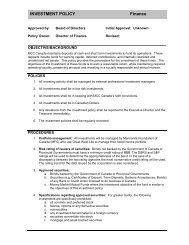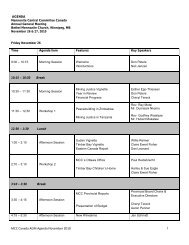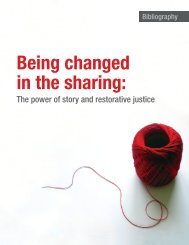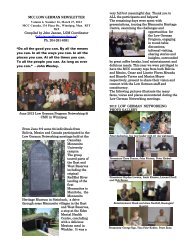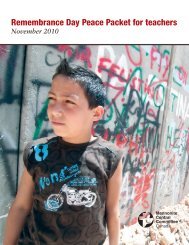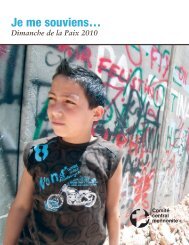Walking together: Healing and hope for Colombian refugees
Walking together: Healing and hope for Colombian refugees
Walking together: Healing and hope for Colombian refugees
You also want an ePaper? Increase the reach of your titles
YUMPU automatically turns print PDFs into web optimized ePapers that Google loves.
w a l k i n g<br />
t o g e t h e r<br />
57<br />
Most <strong>Colombian</strong> <strong>refugees</strong> will have experienced several, if not most of these different layers of trauma.<br />
Traumatic stress is the physical, mental or emotional response to having experienced traumatic events.<br />
These responses to the traumatic event are normal, <strong>and</strong> can be understood as coping mechanisms that<br />
trauma survivors use to get through difficult or traumatic situations. However, over time these responses<br />
- the symptoms or expressions of trauma - if maintained, become dysfunctional. For example if a person<br />
whose life is in danger wakes up frequently during the night, this trauma response/symptom may<br />
actually save her life by ensuring that she is constantly aware of what is going on around her <strong>and</strong> able<br />
to detect any potential danger. However, assuming this person is now in Canada <strong>and</strong> safe from danger,<br />
constant waking up throughout the night now serve no useful purpose - this trauma symptom has now<br />
become an inappropriate coping mechanism.<br />
Although it might seem illogical that trauma symptoms would continue or return after the survivor has<br />
arrived in a safe environment, the fact is they often do. Trauma symptoms often take time to go away,<br />
even when the survivor is no longer in immediate danger. When <strong>refugees</strong> move to a different country,<br />
they face many stressful life changes while at the same time the support systems that they had in place<br />
to help them cope in their home country are taken away. The stressful events of the transition may trigger<br />
earlier symptoms of trauma, causing those responses to show up again, even though they are no longer<br />
appropriate or needed.<br />
Despite the wide variety of ways in which humans respond to trauma, the same range of effects <strong>and</strong><br />
responses is common to all kinds of traumas. 18 This means that if you have ever experienced a traumatic<br />
event, such as a life-threatening accident, a devastating storm or earthquake or a sudden death of a loved<br />
one, you may have experienced some of the same physical, emotional <strong>and</strong> social trauma responses as<br />
the refugee family has experienced. Nonetheless, it is very important to remember that when a traumatic<br />
event was premeditated <strong>and</strong> carried out by other human beings, which is the case <strong>for</strong> war <strong>and</strong> human<br />
rights abuses, the effects of the trauma tend to be more severe <strong>and</strong> longer lasting. Recognizing that<br />
responses to different kinds of trauma are similar can take some of the mystery out of talking about<br />
trauma <strong>and</strong> its effects while also helping us to empathize <strong>and</strong> to give more effective support.<br />
Since many of the responses or symptoms of trauma are “silent” <strong>and</strong> could easily go undetected it is<br />
important to listen <strong>and</strong> watch <strong>for</strong> both verbal <strong>and</strong> non-verbal signs of trauma. By learning what to look <strong>for</strong>,<br />
how to look <strong>for</strong> it, <strong>and</strong> how to respond you can be part of the process of restoration from trauma.<br />
Resilience is the capacity of individuals <strong>and</strong> communities to adapt, survive <strong>and</strong> bounce back in the midst<br />
of or after hardship <strong>and</strong> adversity. The term resilience comes from the fields of physics <strong>and</strong> engineering,<br />
<strong>and</strong> refers to elasticity - an ability to bend <strong>and</strong> stretch without breaking. Resilient people are able to return<br />
to equilibrium <strong>and</strong> a level of functioning the same as or greater than be<strong>for</strong>e a crisis, tragedy or trauma,<br />
<strong>and</strong> to live with <strong>hope</strong> <strong>and</strong> joy despite adversity.<br />
18. Evelyn C. Lennon, MSW, MA. (2005) New Neighbours Hidden Scars, chapter 3 <strong>Healing</strong> the Hurt. Minneapolis, MN: The Centre<br />
<strong>for</strong> Victims of Torture, www.ctv.org



